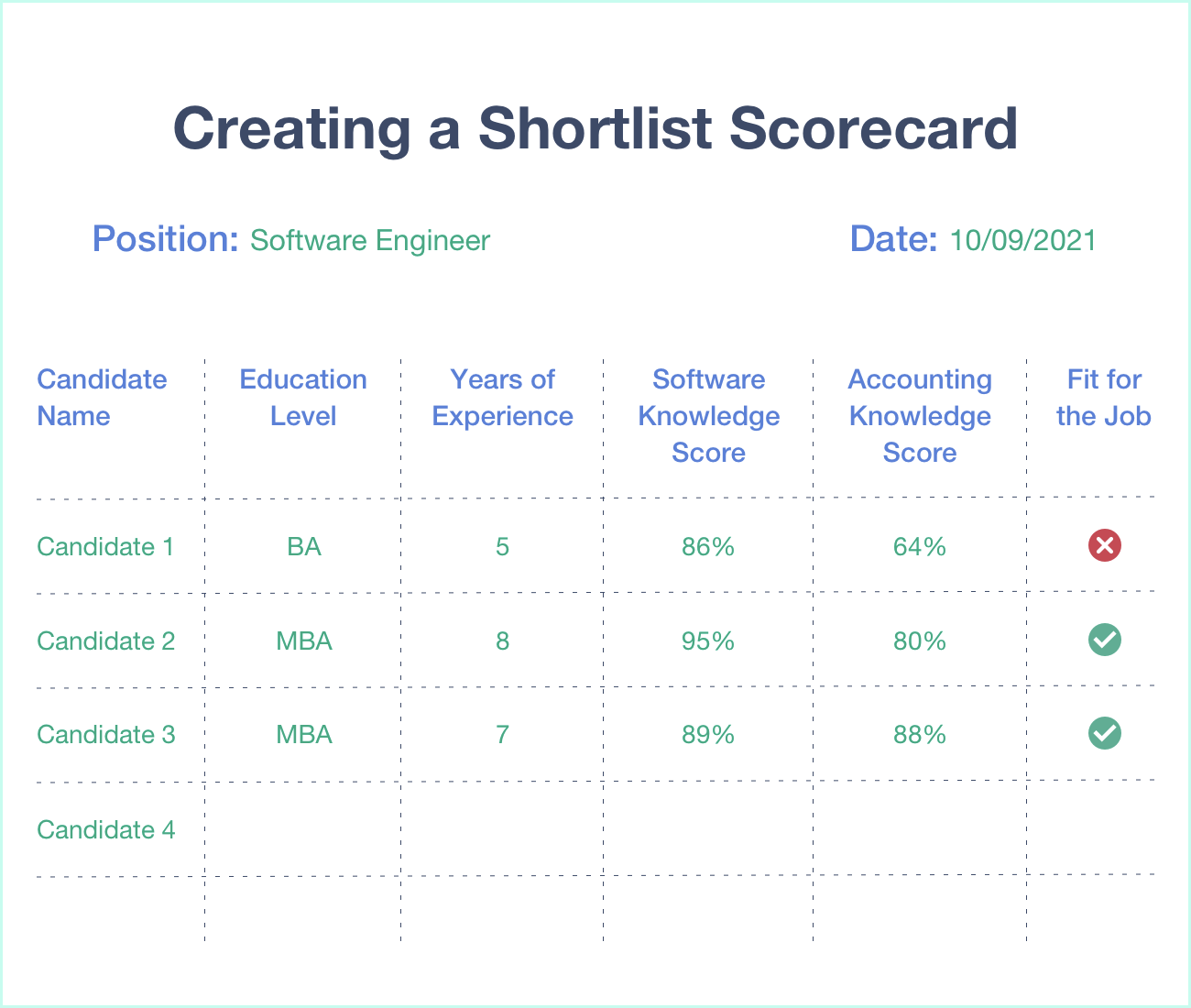You’ve posted your ad and received a big stack of applications from job seekers. But now, how do you decide which prospects are top candidates and deserve to come in for an interview? Below, we’ll take a look at why and how to shortlist job applicants, including how to establish your selection criteria for shortlisting applicants, and how to remain objective and fair during the process.
The role of shortlisting in the recruitment process
When recruiting and hiring new employees, shortlisting candidates is the process of narrowing down a list of applicants to those who are best qualified and have the necessary experience, skills, and personality traits for a particular job. Basically, shortlisting candidates takes place after you’ve posted the ad, received résumés, and given and reviewed results of initial pre-employment testing.
Knowing how to shortlist résumés saves you time and conserves resources because it helps you focus on top candidates and avoid interviewing those who aren’t qualified. Once you’ve pared down your pool of candidates, you can begin the interview process.
Shortlisting principles to follow
Knowing how to shortlist job applicants is a necessary part of the hiring process, but it can have legal repercussions if not done properly. Your decisions need to be based on clear data and job-related factors. That’s why it’s critical to understand how to shortlist résumés and create a method that’s as fair and objective as possible. Following a few shortlisting principles will help you remain consistent and impartial as you select candidates to eliminate or keep:
- Be objective and aware of your bias. Everyone has unconscious biases — we’re just naturally predisposed to like people who have things in common with us — but it’s important to recognize this and ask yourself whether you’re selecting a particular candidate only because they are “like you” in some way. Taking steps to identify and limit implicit bias is an important part of fostering diversity, equity, and inclusion in your workplace.
- Establish clear criteria. Have clear, documented selection criteria for shortlisting applicants that outline the skills and traits a person needs for the job, and compare every candidate to that criteria.
- Avoid conflicts of interest. Make sure there are no close connections between your hiring team and any candidate for the position. For instance, no one on the selection committee should be related to any candidate. All hiring team members must understand how to shortlist résumés objectively.
How early testing leads to quicker, easier shortlisting
The best way to improve your shortlisting is to start your search by establishing the necessary experience, skills, and traits that an ideal job applicant will have. Those decisions will inform every aspect of your hiring process, from crafting advertisements that attract the right candidates to helping you know how to shortlist résumés to focusing interviews.
But the real key is to incorporate pre-employment testing, such as personality and aptitude testing, early in your hiring process to assess applicants for those skills and traits. A good personality test, measured against pre-established baseline data, is the best way to make sure a candidate is the right fit for the role and your company.
The earlier you establish how candidates stack up against your benchmark and one another, the quicker and more confidently you can move forward to the interview stage, helping you save precious time and resources, and just as importantly, avoid hiring the wrong person.
The right applicant tracking system can make shortlisting much quicker and easier. You can flag résumés that meet your selection criteria for shortlisting applicants as well as automatically compare candidates’ test scores against established baselines and one another. The automation plus early testing can vastly improve your hiring process by simultaneously reducing administrative burden and time to hire.
Move beyond resumes, identify true potential
Make smarter hiring decisions using objective data on candidates' strengths, work styles, and personality traits.
Book a Demo Try It Free6 Simple Steps to Shortlist Candidates for an Interview
Following the shortlisting principles outlined below will help ensure that the process is as fast, easy, and objective as possible, allowing the best and most qualified applicants to be selected for interviews.
1. Establish your shortlisting criteria
When establishing your criteria for shortlisting candidates, start by determining which qualities and skills are essential for the job and which additional abilities would simply be nice to have. If you currently have an employee in the same role you’re hiring for — or a manager who will oversee the new employee and knows the job well — talk with them about the attributes they feel are most important for success. Testing can be utilized at this stage to get objective baseline data. In addition to abilities and personality characteristics, remember that the job may also require a particular level of education, degree, certification, work experience, and/or training.
You should put together this list before you ever begin writing a job description or job ad so that you’re sure to include all the necessary information for both your own staff and for job seekers. The following selection criteria for shortlisting applicants should be established before proceeding with advertising and the rest of the hiring process:
- Skills and capabilities. These are the required abilities and tasks for the job, such as the use of specific equipment, software, technology, and/or other industry-related knowledge.
- Education. If the job requires a particular level of education, training, certification, or degree, make note and be sure to state that clearly in your posting.
- Work experience. You may determine that having a particular work experience is important to a candidate’s success in a position. If so, be sure to clearly convey what background is required, including years of experience, type of work in your industry or related industries, etc.
- Cultural fit. Don’t forget to factor in how your work environment and overall company values affect the position.
- Personality. Going back to your benchmarking for the position, list the personality traits necessary for success in the role, such as “detail-oriented,” “outgoing,” or “independent worker.”
2. Create a shortlist scorecard

Creating a scorecard for each candidate is one of the best shortlisting principles because it makes the process easier and more consistent, helping you visually understand how different applicants stack up. Using your job baseline as a guide, create a system to allocate points for your ideal skills and traits. For instance, you might assign a set number of points to each candidate who knows a particular software, has the degree or certification you’re looking for, etc.
You could create your scorecards any number of ways, either by hand, in a spreadsheet, or with the help of specialized software. Indeed, some hiring systems create their own versions of scorecards you can use for shortlisting candidates. And if you do opt for a system, consider using it to hide preselected information like profile photos or names during the scoring process; it can help eliminate bias and ensure an objective, data-driven process, so you’re more confident that you’re hiring the right people.
3. Determine how many candidates to shortlist
The number of candidates you decide to include in your shortlist and bring in for interviews will probably vary greatly, depending on the size of your company, how much time you have to hold interviews, and how quickly you want to get someone on board and into the role. But establishing a mark to hit can focus the hiring process.
That said, circumstances — for example, how many people apply, how many applicants meet the minimum requirements, and how many have high-enough scores on pre-employment tests — may effectively raise or lower your number of shortlisted candidates.
4. Decide which tests or additional questions to give applicants
As discussed above, a comprehensive applicant tracking and testing system will help you shortlist candidates faster by automatically comparing applicants to your baselines and pre-established criteria. To that end, you need to decide which tests to administer, such as a personality test or a skills test focusing on a particular software program, to better identify top candidates. Adding the right pre-employment tests to your hiring campaigns is an excellent, objective way of speeding things up and can help you avoid wasting time on unqualified applicants.
Invest in future performance, predict long-term fit
Use our personality assessment to identify candidates who will thrive in their role and in your evolving organization.
Book a Demo Try It Free
5. Shortlist applicants who have met your criteria
When done properly, shortlisting doesn’t just help screen candidates; it also gives you the chance to focus attention on the qualities and merits of top prospects. If you’ve done it right, you’ll be able to quickly compare your best prospects to one another and against your expectations. Then, you can select the best of the best and move them on to the next stage, typically interviews.
And you’ll be able to apply the information you gathered on your scorecard to focus your interview process. For instance, you might want to follow up with a particular question that fills in a gray area in the data and helps you make your final decision.
6. Notify applicants who didn’t make it through shortlisting
As soon as you can, notify those applicants who were eliminated from your search. This is a best practice and professional courtesy, and it allows job seekers to focus their energies on other applications.
It also gives you a chance to thank them for their interest in your company. Remember: If their personality and test scores suggest that they’d be an excellent fit for your company, you can encourage them to apply another time. Just because they aren’t the right person for this role doesn’t mean they wouldn’t be perfect for another one!
Shortlisting gives you the time to spend on qualified candidates
Knowing how to shortlist job applicants has many benefits, resulting in shorter, more-focused hiring campaigns and more time to spend on qualified candidates. And with a comprehensive online hiring system like Hire Success®, you can benefit from all the tools described above — including baselines and pre-employment aptitude and personality tests — and speed up the hiring process.


